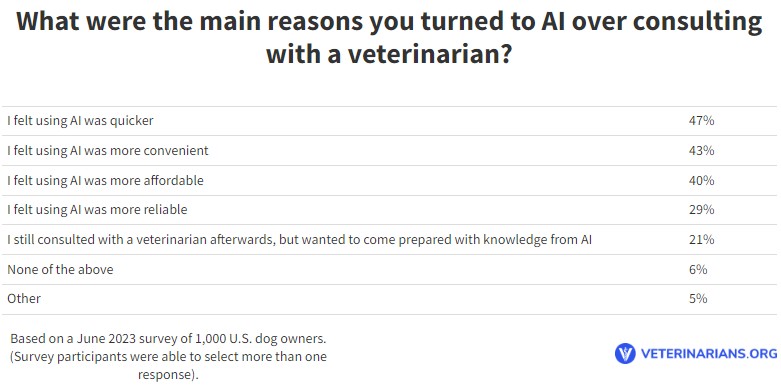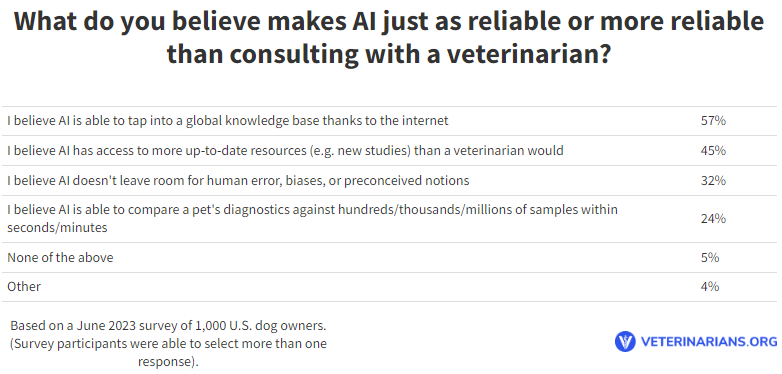The Rise of AI in Pet Care

Table of Contents
In recent years, the world has witnessed an unprecedented surge in technological advancements, and the field of pet care is no exception. Artificial Intelligence (AI) has steadily carved its niche in various sectors, and now it is revolutionizing how dog owners tend to their canine companions.
With the promise of quick and accessible solutions, more and more pet parents are turning to AI for canine health and behavior analysis. But as we navigate through this digital transformation, it is crucial to understand the implications and considerations of relying on AI for pet care.
The Special Reports Team at Onevet.ai surveyed 1,000 U.S. dog owners online to discover how the rise of AI is impacting healthcare decisions related to pets and to better understand the reasons that are driving more and more Americans to turn to AI when it comes to their canine companions.
Survey Results
Roughly 1 in 8 U.S. dog owners have used Artificial Intelligence in the past year to diagnose their pet.
The more dogs a person has, the more likely they are to use AI for a diagnosis. While only 10% of single-dog households have used AI for this purpose, that number increases to 14% in households with two dogs, 17% in households with three dogs, 19% in households with four dogs, and then jumps significantly to 42% in households with five or more dogs.
Among those who have used AI to diagnose a pet, the majority (47%) have opted for this route over consulting a veterinarian for the benefit of receiving quicker results, though 40% stated affordability as a reason as well. In fact, 44% of AI-using dog owners have opted out of health insurance altogether for their dog, with the policy’s monthly cost being the main reason for doing so for more than half (54%) of these respondents.

The majority (47%) of dog owners who have used AI to diagnose their pet believe AI is just as reliable as consulting with a veterinarian, with an additional 24% believing AI is more reliable.
Among these respondents, the most common reason given for rating the reliability of AI so highly (or on par with the reliability of a veterinary consult) was the belief in AI’s ability to tap into a global knowledge base thanks to the internet (57%).

AI users are also more likely than non-AI users (67% vs. 33%) to turn to Google at least once a week to learn more about issues related to their pet (medical/health issues, behavioral issues, training issues, diet issues, etc.).
Among all dog owners who use Google at least weekly, the majority (34%) describe the search results generated by Google as extremely trustworthy, while 30% describe search results as “somewhat trustworthy.”

The Rise of AI in Pet Care
The integration of AI in canine care is a testament to how technology can enhance the quality of life for both pets and their owners. AI-powered tools and applications are designed to offer insights, advice, and solutions based on the data inputted by the user.
These tools range from symptom checkers and behavioral analysis applications to virtual veterinary consultations. The appeal lies in their accessibility and the promise of immediate responses, making pet care seemingly more manageable, especially for new or busy dog owners.
Considerations for Dog Owners
While the convenience and accessibility of AI in pet care are undeniable, it is essential for dog owners to approach these tools with caution and mindfulness. Here are some key considerations to keep in mind:
- Accuracy and Reliability: AI tools are only as good as the data they are trained on and the input they receive. Misinterpretation of symptoms or incomplete information can lead to inaccurate advice. Always cross-check the information provided by AI tools with reliable sources or seek a second opinion from a professional veterinarian.
- Limitations of AI: AI in pet care is not a replacement for professional veterinary care. It should be used as a supplementary tool rather than the sole basis for medical or behavioral decisions. AI cannot perform physical examinations, conduct tests, or understand the nuances of a pet’s condition like a veterinarian can.
- Data Security: When using AI-powered tools, consider the security of your pet’s information. Ensure that the application or service adheres to strict data protection and privacy policies.
- Emotional Intelligence: AI lacks the emotional intelligence that is often crucial in understanding and responding to a pet’s needs. Observing your dog’s behavior, body language, and changes in habits remains an invaluable aspect of pet care that AI cannot replicate.
Popular AI Modalities for Dog Owners
As the demand for AI in pet care grows, so does the variety of available tools and services. Here are some of the most popular AI modalities that dog owners are embracing:
- Symptom Checkers: These AI tools allow dog owners to input their pet’s symptoms to receive potential diagnoses or advice on the next steps to take. They are designed to help pet parents make informed decisions about whether a vet visit is necessary.
- Behavioral Analysis Apps: By inputting information about their dog’s behavior, owners can receive advice and training tips tailored to their pet’s specific needs. These apps aim to address behavioral issues and enhance the pet-owner bond.
- Virtual Veterinary Consultations: These platforms connect dog owners with licensed veterinarians via video calls, allowing for immediate professional advice. While they do not replace in-person vet visits, they provide a valuable resource for preliminary consultations and follow-up care.
- Pet Trackers and Monitors: Using AI, these devices analyze a dog’s activity levels, sleep patterns, and more, providing owners with insights into their pet’s health and wellbeing. Some also offer alerts for irregular behavior or signs of distress.
- Diet and Nutrition Apps: These tools help dog owners tailor their pet’s diet to their specific needs, taking into account factors like age, breed, weight, and health conditions. They provide recommendations for commercial dog food or recipes for homemade meals.
The integration of AI into canine care represents a significant leap forward in how we tend to our furry friends. The convenience, accessibility, and insights provided by these tools have the potential to enhance the quality of life for dogs and make pet care more manageable for owners.
However, it is imperative to approach these tools with a critical eye, understanding their limitations, and always prioritizing the advice of professional veterinarians. As we navigate this new era of pet care, let us embrace the possibilities that AI offers while remaining mindful of the responsibility that comes with pet ownership.
*The survey analyzed for this report was administered online on June 10, 2023 through the survey platform Pollfish and included no less than 1,000 respondents.















